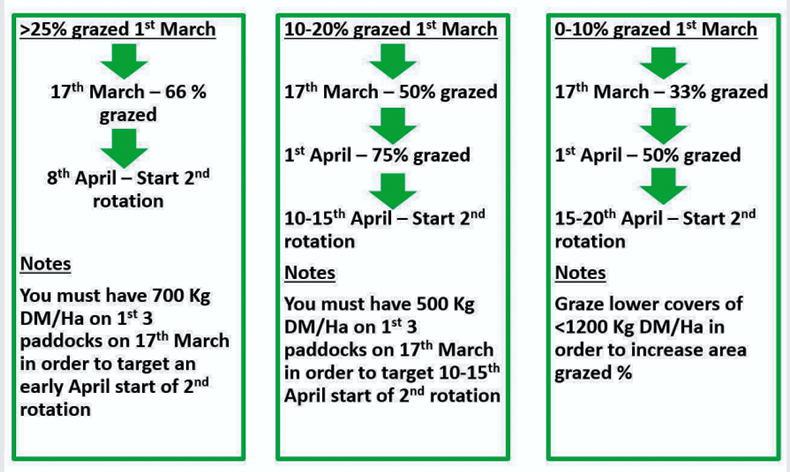It’s been another tough week on the grazing front, with the return of rain right across the country leading paddocks to become a sticky mess yet again.
Some very dry farms may be on target for the time of year regarding percentage grazed, but for many it will be a game of catch up and with weather patterns indicating a wet St Patrick's weekend, this will only further exacerbate the grazing difficulties farmers face.
With growth predicted to creep into the 20s this week, the percentage of the farm grazed will have to be increased to target regrowth for the second rotation.
Pushed-out second round
In all likeliness, commencement of the second round will have to be pushed out for farms behind grazing targets.
Pasturebase Ireland has the information below regarding where a farm may lie regarding percentage grazed and the targets it now needs to hit.

Adjustments to the spring rotation planner will be required where difficult grazing conditions has resulted in a low percentage of the farm grazed. Source: Pasturebase Ireland
On dairy farms, on-off grazing with cows should still be the priority, but if yearling heifers are to hand, it may be an option to turn these out on to the grazing block.
Not only will it help drive on weight gain in them ahead of bulling, but, more importantly, will help get grass grazed and back growing again for the second round.
On beef farms, the priority stock on farm is also likely the lightest and most suitable to graze.
Yearlings can be turned out in small bunches over a large area, with semi-decent graze-outs rather than cattle nailing covers likely a more achievable goal.
First-calved beef heifers should also be earmarked for grass, as they will likely be in an energy deficit indoors, while trying to grow and produce milk at the same time.
Where cows or ewes are turned out to grass in such mixed conditions as we are having, concentrate supplementation should be used to prevent any issues regarding grass tetany.
It’s been another tough week on the grazing front, with the return of rain right across the country leading paddocks to become a sticky mess yet again.
Some very dry farms may be on target for the time of year regarding percentage grazed, but for many it will be a game of catch up and with weather patterns indicating a wet St Patrick's weekend, this will only further exacerbate the grazing difficulties farmers face.
With growth predicted to creep into the 20s this week, the percentage of the farm grazed will have to be increased to target regrowth for the second rotation.
Pushed-out second round
In all likeliness, commencement of the second round will have to be pushed out for farms behind grazing targets.
Pasturebase Ireland has the information below regarding where a farm may lie regarding percentage grazed and the targets it now needs to hit.

Adjustments to the spring rotation planner will be required where difficult grazing conditions has resulted in a low percentage of the farm grazed. Source: Pasturebase Ireland
On dairy farms, on-off grazing with cows should still be the priority, but if yearling heifers are to hand, it may be an option to turn these out on to the grazing block.
Not only will it help drive on weight gain in them ahead of bulling, but, more importantly, will help get grass grazed and back growing again for the second round.
On beef farms, the priority stock on farm is also likely the lightest and most suitable to graze.
Yearlings can be turned out in small bunches over a large area, with semi-decent graze-outs rather than cattle nailing covers likely a more achievable goal.
First-calved beef heifers should also be earmarked for grass, as they will likely be in an energy deficit indoors, while trying to grow and produce milk at the same time.
Where cows or ewes are turned out to grass in such mixed conditions as we are having, concentrate supplementation should be used to prevent any issues regarding grass tetany.







 This is a subscriber-only article
This is a subscriber-only article










SHARING OPTIONS: